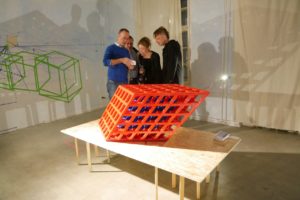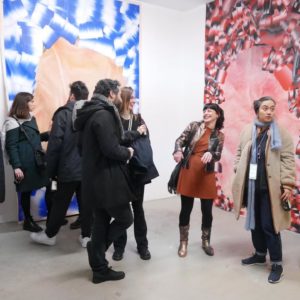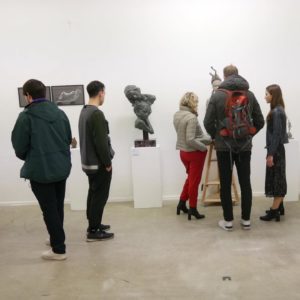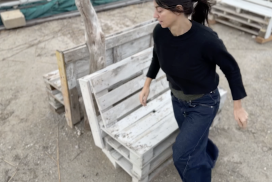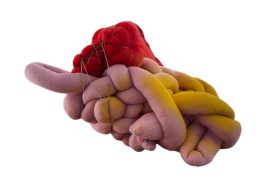Entering the first floor, visitors encounter Nicole Dyer’s work, focusing on the dichotomy of eating and sharing—how a plate of food can be both nourishing and dangerous; or how someone alone can feel connected through social media. Alejandro Urrutia uses the medium of sculpture to play with how architectural rules can be reinterpreted and transgressed. Folded steel sheets become pieces positioned in space that challenge forces in equilibrium. At the intersection of math, engineering and visual arts, Ian Jehle’s large-scale installation includes wall drawing, lecture notes, and LEGO blocks, outlining Jehle’s thinking about infinities, selfreference and the mathematical impossibility of mathematical perfection.In her painting practice, Daniela Schwabe questions the complexity of the real in an age of manufactured copies, using artificial intelligence and deep learning to imitate her own work process. Astrid Lloyd’s Spinnmaschine takes the spinning wheel as a point of departure for reflection on prominent philosophical, literary and political ideas in the German context, and the significant role played by textile traditions and industry in German nation-building.
Reaching the second floor, Dani Toral creates immersive spaces, paintings, ceramic and paper-mache objects through bold markmaking and vibrant color palettes that reflect her rich Hispanic culture. Kyle Giacomo’s paintings are a narrative of fragmentary cartoon-like overlapping figures that form a kind of unconscious play, like images emerging and stuttering into existence before fully forming. Laura Palau’s Las bañistas documents what happens in the women’s changing rooms of different swimming pools with the aim of showing and preserving one of the few women-only spaces that remain in today’s society. In Children of Agape, Alexandra Slava explores the idea of the highest form of love as an equilibrium of forces giving birth to new life with the embodiments of Mother, Male and Female as abstract elements of nature rather than literal depictions. Ismael Iglesias blends the traditional pictorial avant-gardism with computer screens’ opaque luminescence by means of systematic fragmentation, giving rise to complex volumetric surfaces where the classic and the futuristic coexist.
Continuing to the third-floor studios, Charmaine Poh’s The Lesson, made in collaboration with dancer Isabel Phua, looks at the manifestations and consequences of intergenerational trauma as embodied in everyday life, with a particular attention on motherdaughter relationships. Heloisa Pomfret’s installation of collages made with industrial materials employs a symbolic and referential language of science to evoke mnemonic letters used to enhance memory or subliminally indoctrinate different ideologies. Both in his studio and throughout the building, Néstor García has been recording different ways of circulating the space that could potentially be decoded back into movement based on his intensive research into Labanotation, a system for recording and analysing human movement that was derived from the work of Rudolf Laban.

























